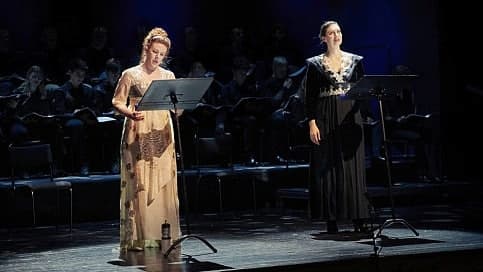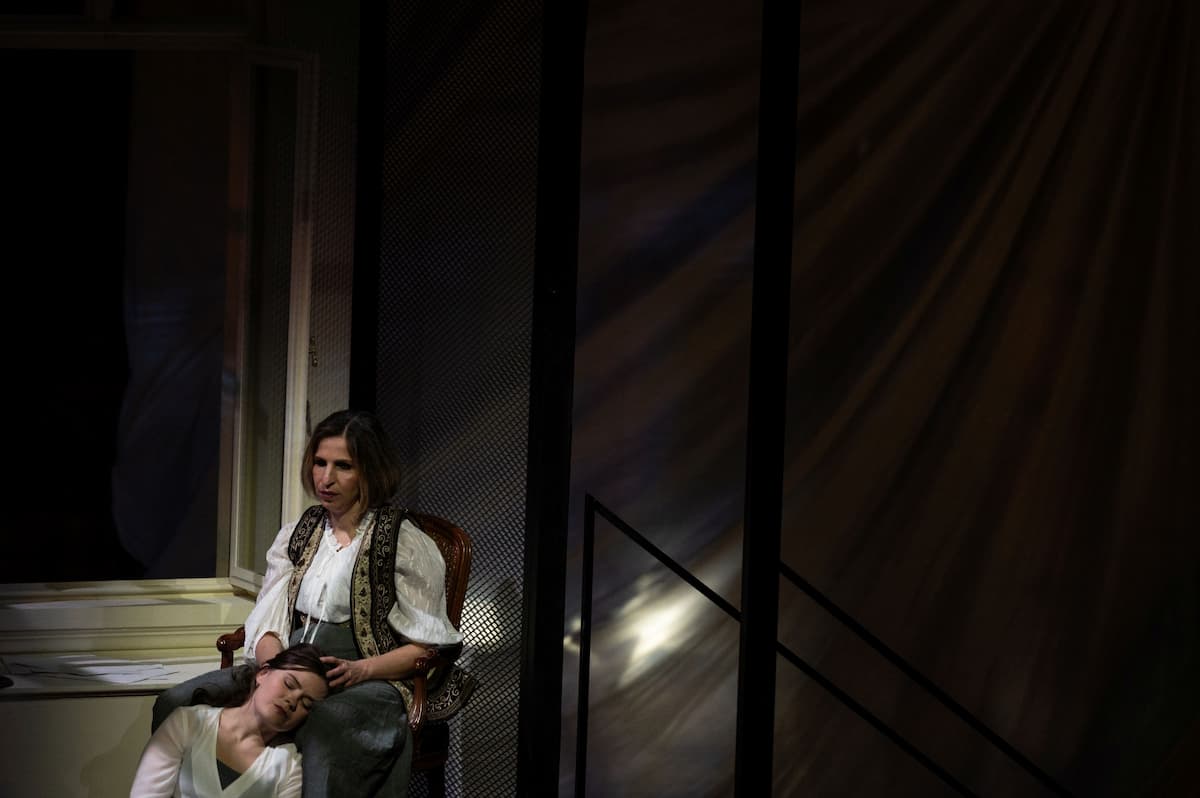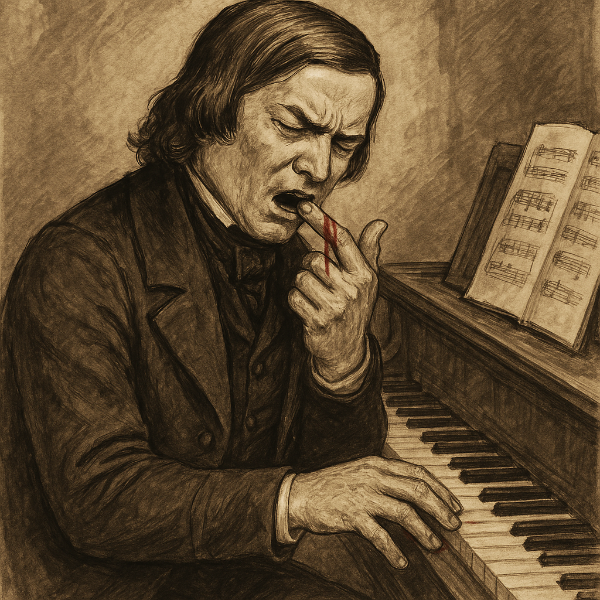In the first part of this article “A Major Minor Opera: Nadia Boulanger’s La Ville morte, A History”, we explored the background of Nadia Boulanger’s opera.
Jumping forward to the modern day, the first staging of the full opera was for the 2005 Chigiania festival in Siena. The staging used a new orchestration by Mauro Bonifacio based on the pre-existing scores. The chorus was used in this production and the role of the nurse was eliminated.
La ville morte di G D’Annunzio/ N. Boulanger
A concert version was done in 2020 at Gothenburg Opera.

The 2020 Gothenburg production with Katarina Karnéus (L) as Hébé and Matilda Paulsson as Anne (photo by Lennart Sjöberg)
For the GNO production, Catapult Opera of New York commissioned American composers Joseph Stillwell and Stefan Cwik to prepare a new orchestration of the work under the supervision of David Conte, who studied with Boulanger from 1975 to 1978 and was one of her last students. The conductor for the GNO production is Neal Goren, founder and Artistic Director of Catapult Opera.
In the Catapult Opera / GNO edition, the chorus and the character of Anne’s nurse have been eliminated, and the cast is kept to the four characters. The orchestra is on stage, placed in what would normally be a stage-left backstage area. Where the 2005 staging had been done with a full orchestra, the Catapult Opera / GNO orchestra was minimal: 2 violins, 1 viola, cello, and double bass, 4 woodwinds, and 1 French horn. The close proximity of the orchestra was a problem as they frequently buried the singers’ lines despite the ensemble’s small size.
Hébé was sung by Melissa Harvey, and the role of the blind Anne by the visually impaired Laurie Rubin. The role of Léonard was sung by Joshua Dennis and Alexandre by Jorelle Williams.
“La ville morte” GNO Preview
The 2024 GNO performance was done on their Alternate Stage, a rectangular black box theatre that’s part of the main opera building. The stage setting centres on a raised room placed at an angle to the audience where Anna spends her time, Hébé reads to her, and the men return to tell of their discoveries – Alexandre of a flight of birds and Léonard of the tombs of Agamemnon, Eurymedon, Cassandra and others. A drape behind the room is used for projections and a drape on the floor becomes a path, the archaeological site, and other places as needed.

Act I: Hébé (Melissa Harvey) rests after reading to Anne (Laurie Rubin), 2024 (Photo by Giorgos Kaklanidis) (Greek National Opera)
Although the program booklet cites arias, they were not clearly delineated. D’Annunzio’s work is remarkably close to another opera from 1898, Debussy’s Pelléas et Mélisande. Boulanger and Pugno’s setting is remarkably close to that of Debussy’s writing, with a little Ravel mixed in. Pelléas et Mélisande is, as Roger Nichols said, one of the first operas that talks rather than yelling all the time, and La ville morte carries on that same style. It’s like a play set to song, rather than a play made into a standard libretto with recitatives and arias substituted for the speeches.
D’Annunzio’s story is about the power of men and so they carry the day, with an attempted seduction of Hébé by Alexandre and the disturbing desire for Hébé by Léonard. Hébé remains an innocent throughout – misunderstanding the tentative advances of Anne, playing with the definite advances of Alexandre, and unaware of the fatal desires of her brother. She’s the spark that brings everyone to life and herself to death.
The music for Hébé is simple, as befits her youth. Anne, however, as the ‘resigned soothsayer’, is more complex. She speaks but hides her emotions. As D’Annunzio characterizes her, her task ‘is to speak of all the beautiful things in the shadow of an antique statue’.
Alexandre’s role is that of the concerned outsider, the observer, but at the same time, in his focus on Hébé, ignores his wife. Léonard is the focus of everyone’s worry: Hébé worries about his health, Alexandre about the secrets he may be keeping, and Anna about the supposed actions of his sister. He, as the archaeologist, is why everyone is suffering in the heat of Mycenae, but with everyone using Hébé as their excuse for their actions, he gets sidelined somewhat.
An opera set around admiration of the heroine’s hair, a fountain as a point of dramatic crisis, and every character’s determination to leave Mycenae can find parallels in Pelléas and Mélisande with Mélisande’s hair, the fountain where she loses her ring, and Pelléas’ oft-repeated desire to leave his grandfather’s palace. Debussy had set the style for both the story (by Maeterlinck) and the musical setting and Boulanger and Pugno followed that French path.
Since we’re seeing it more than a century after its intended premiere, we have to ask ourselves about its place in the opera pantheon. Only one opera from 1914 is still in repertoire: Stravinsky’s The Nightingale, with Zandonai’s Francesca da Rimini (note: after the play by D’Annunzio) making an occasional appearance. In the grand scheme of a composition by a young composer (Boulanger would have been 26 in 1913) and an experienced composer (Pugno would have been 61 in 1913), the work remains a minor opera, despite its libretto by D’Annunzio. The style of music in early 20th-century France was undergoing changes. The new ideas of Debussy were affecting music, especially in comparison to the operas by Berlioz and Wagner that still held the major stages.
It was an interesting evening hearing a new/old opera. I don’t think that it will ever take its place on the major stages, unless someone really wants to add in everything that the Opéra-Comique would have committed to the project, including the extra character and chorus. Since it was not produced during its composers’ lifetimes, we don’t know what they would have added or changed once they saw it staged.
Stories of innocent victims of others’ desires may not have a place on the modern stage, but for this evening, it was a delight to hear.
For more of the best in classical music, sign up for our E-Newsletter
Greek National Opera
La ville morte by Nadia Boulanger and Raoul Pugno
January 19, 21, 24, 26, 28, 2024
The production then moves to New York: April 19, 20, 21, 2024 at NYU’s Skirball Center



